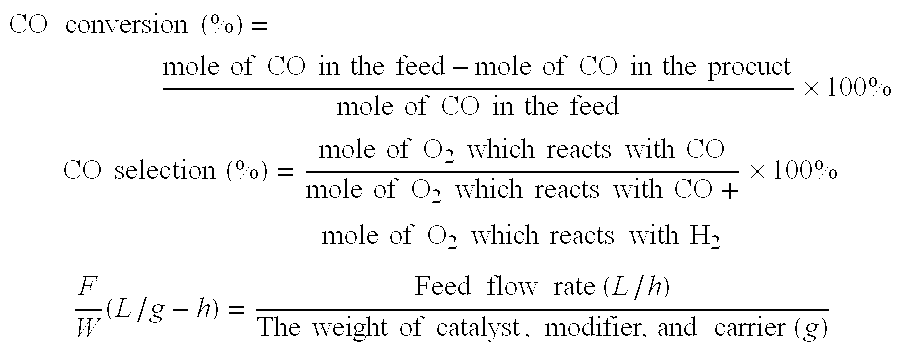Vermiculite supported catalyst for CO preferential oxidation and the process of preparing the same
a vermiculite-supported catalyst and co-preferential oxidation technology, which is applied in the field of catalysts, can solve the problems of fuel cell anode, wgs reaction not being sufficient to reduce the co content in the effluent, and being vulnerable to sulfur-poisoning in the exhaust gas stream, etc., and achieves high absorption efficiency, high thermal durability, and high efficiency
- Summary
- Abstract
- Description
- Claims
- Application Information
AI Technical Summary
Benefits of technology
Problems solved by technology
Method used
Image
Examples
example 1
Vermiculite-Supported Catalyst with 50 wt. % Cu(NO3)2.3H2O
[0030]The vermiculite-supported catalyst was prepared by the following procedures. Step (1): 0.611 g of ZrO(NO3)2.8H2O was combined with an appropriate amount of RO water in a beaker and the mixture was dissolved by ultrasonication for around 10 minutes. Step (2): 5.8423 g of Ce(NO3)3.6H2O and appropriate amount of RO water were then mixed with the Zr-containing solution just prepared to form the carrier material solution, which weighed 11.68 g in total (Ce / Zr molar ratio of the carrier material solution is 0.9 / 0.1). The Ce / Zr carrier material solution then underwent ultrasonication for about 10 minutes to ensure complete dissolution. Step (3): The Ce / Zr carrier material was precipitated onto the vermiculite support by first adding 1.536 g of vermiculite into the prepared Ce / Zr carrier material solution. The resulting mixture was adjusted with appropriate amount of ammonia to give a final pH of about 10˜11 and allowed to age ...
example 2
Vermiculite-Supported Catalyst with 60 wt. % Cu(NO3)2.3H2O
[0034]A vermiculite-supported catalyst of the present invention was prepared by the procedures similar to that in Example 1 except that in Step (6), the carrier-containing vermiculite support prepared (Step 5) was wet impregnated with 60 wt. % Cu(NO3)2.3H2O.
[0035]The measuring procedures for determining the vermiculite-supported catalyst performance is the same as that in Example 1 except that some experimental parameters, such as feed rate, and feed composition were varied due to control limitation. The feed gas is composed of 2.02% CO, 1.74% O2, 15% CO2, and 48% H2 in N2, and the feed rate is 72.55 cc / min to give F / W of 27.89 L / g-h. The overall performance of the vermiculite-supported catalyst is summarized in Table 2.
TABLE 2The overall performance of vermiculite-supported catalyst with 60 wt. %Cu(NO3)2•3H2O solutionCOReactionconcentrationCO concentrationCOCOtemperaturein the feed endin the product endconversionselectivity(...
example 3
Vermiculite-Supported Catalyst with 25 wt. % Cu(NO3)2.3H2O
[0036]A vermiculite-supported catalyst of the present invention was prepared by the procedures similar to that in Example 1 except that in Step (6), the carrier-containing vermiculite support prepared (Step 5) was wet impregnated with 25 wt.% Cu(NO3)2.3H2O.
[0037]The measuring procedures for determining the vermiculite-supported catalyst performance is the same as that in Example 1 except that some experimental parameters, such as feed rate, and feed composition were varied due to control limitation. The feed gas is composed of 2.01% CO, 1.73% O2, 15% CO2, and 48% H2 in N2, and the feed rate is 72.55 cc / min to give F / W of 27.89 L / g-h. The overall performance of the vermiculite-supported catalyst is summarized in Table 3.
TABLE 3The overall performance of vermiculite-supported catalyst with 25 wt. %Cu(NO3)2•3H2O solutionCOReactionconcentrationCO concentrationCOCOtemperaturein the feed endin the product endconversionselectivity(°...
PUM
| Property | Measurement | Unit |
|---|---|---|
| Temperature | aaaaa | aaaaa |
| Temperature | aaaaa | aaaaa |
| Time | aaaaa | aaaaa |
Abstract
Description
Claims
Application Information
 Login to View More
Login to View More - R&D
- Intellectual Property
- Life Sciences
- Materials
- Tech Scout
- Unparalleled Data Quality
- Higher Quality Content
- 60% Fewer Hallucinations
Browse by: Latest US Patents, China's latest patents, Technical Efficacy Thesaurus, Application Domain, Technology Topic, Popular Technical Reports.
© 2025 PatSnap. All rights reserved.Legal|Privacy policy|Modern Slavery Act Transparency Statement|Sitemap|About US| Contact US: help@patsnap.com

